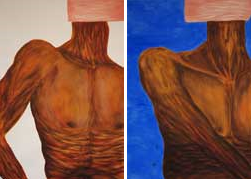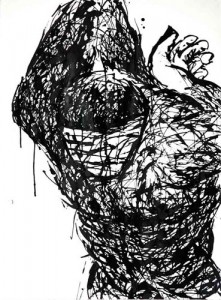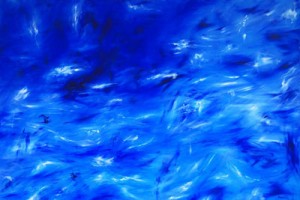Guest post by Omar Mohammed.
Nadir has worked as an architect in numerous countries including Britain, Ethiopia, Germany, India and Saudi Arabia. He is the founder of Tharani Associates Ltd, one of the leading architectural firms in Dar es Salaam.
Nadir has just completed work on a new collection of paintings, a series titled Origins that will be on show at the Alliance Française. The launch of the exhibition will be on the 29th March — only by invitation. The exhibition will officially be opened on the 30th March and will run till the 8th of April.
1. When did you realize that you were an artist?
Like everyone else, school urges us to draw, to represent reality or to provoke it by dreaming with drawings or paintings or making and forming objects. Everyone is an artist or rather everyone wants to be one (those who don’t have not yet realised this). So [for me] there was no exact moment of realisation.
But this form of ‘indulgence’ ended at Form II at Mawenzi, because then the school had no money for paint. But I studied A-Level Art and was encouraged and I continued to do bits and pieces when studying architecture.

2. You are an architect, a writer and a painter. How do you negotiate your way through these different art forms?
They are different practises, different forms that require their own particular discipline and thought. Writing does help in articulating one’s intention or a painting but really painting uses the visual senses which, by the way, are the first senses that we use when we are born. Language comes afterwards.
Architecture is something different entirely. One has to take into account history, the site or the surroundings, possible views, and of course the climate (the movement of the sun, the breeze, how to stop the rain coming through), etc. Realisation of a design is mainly a management exercise – you have to wear shoes then.
Somewhere, somehow, there must be a link; there may be common intentions, example, wanting to capture the thick yellow light before dusk, but the process and the actual mechanism is different when it comes to architecture than, say, painting dusk.

3. What inspires you and how is your process like?
Surroundings; looking and seeing and thinking.
Sometimes, external events provoke and necessitate [that I paint]. For example, my series of paintings such as ‘the neck, the shoulder…’ came about that way. I describe them as being inspired by: “When things don’t go too well at home, or at the bar, or at school or work, or when they bomb you from the air on your way to your wedding, or when you are dreaming, I suppose these are the positions you take.”
In other words they are an observation of how the human body presents a defiant stance in the context of different kinds of oppression: societal, familial, political.
Similarly, the constant terror of rendition and imprisonment, wars and imposition of power that we are subjected to resulted in a series entitled Positions of Power which were exhibited at the Alliance Française in 2008 in Dar es Salaam.
These were also drawings “on the arbitrary detention, harassment, beating, torture, rape and imprisonment of those who are seen as not conforming to the strictures of power – from fruit hawkers, children at school, voters, passengers, dreamers, strollers, to those who seek a more equitable life for all.”
I saw the alignment imposed on the human body by those in power as postures that embody power relations in their raw, brutal form; very direct, the body itself subjected and twisted by power as opposed to one receiving a summons or being asked to keep quiet.
One can say thinking about life, seeing and reading about these events provokes sheer horror at this constant exercise of barbarism, and since striving for an equitable life for all should be a precondition for one’s existence in these times, Art cannot be an exception.

4. On the 29th of March 2011, the Alliance Française in Dar es Salaam will exhibit your new collection of paintings. Can you talk about these new works and what you aim to achieve with this collection?
It may seem to be very much further from the previous work, but it is nevertheless concerned with seeing and thinking. It is a series of paintings called Origins on light, movement and water that which surrounds us, where light is at its most material (you can run your fingers through it).
It is also about movement and traces, both above and below the surface of water.
I wanted to move away from the constant depiction of animals, of people jumping and not jumping with spears, ie to suggest that painting here should not necessarily follow the stereotype of Tanzania/Africa, a stereotype that is held by the outside world but not the 20 million mobile phone users here.
I wanted to explore surroundings, things that one sees everyday or occasionally. For example the painting Dancing Night stems from a memory of drinking by a stream in the evening and watching reflected light jump, dance, turn and flow, and perhaps there is a memory of ‘pachanga’ steps embodied in the movement as well.
Although, [these new works] may be seen as abstract, I feel [they are] very much rooted in life here.
5. What would you say to a young Tanzanian artist just starting out?
Look, see, draw, think, research, think and draw/paint/sculpt, look, see….

This interview has been condensed and edited. For more on Nadir Tharani please visit his website at www.nadirtharani.com.
Related interviews:
- Dar Sketches’ Sarah Markes
- Spearhead Branding and Kina Klothing’s Mkuki Bgoya
- African Digital Art Founder Jepchumba
- Cartoonist FeDë Nestory
Update:
The launch of the exhibition will be on the 29th March — only by invitation. The exhibition will officially be opened on the 30th March and will run till the 8th of April.


Do you think we can create public space in TZ where people can freely practice their art?
I’m sure public spaces to display or practice art exist even today, but I think one of the bigger problems artists experience in Tanzania is recognition and compensation. There are still unresolved questions about how an artists’ work should be accessed by the public.
But @anon, I think what you are trying to ask is if art can be a public phenomenon as opposed to a closed, “invitation-only” phenomenon. I think this is quiet an important question, and I look forward to seeing more responses here! Cheers.
If Nadir is right that all of us want to be artists, then I must be amongst those who have yet to realize this. This is why reading Nadir’s text was so interesting because it illuminated the intentionality behind his art. Thank you for making this interview possible. I am sorry I can not be in Dar to see the exhibit over the next few weeks. Is there no way of persuading Alliance Francaise to show the exhibit at their sites in Kampala and Nairobi?
@Mahmood, I think it is definately possible, but we’ll have to see who we can get in touch with for that.
If you haven’t already, you can also refer to Nadir’s website: http://www.nadirtharani.com
Cheers!
@Mahmood – I’ll forward your request to the AF representative in Dar.